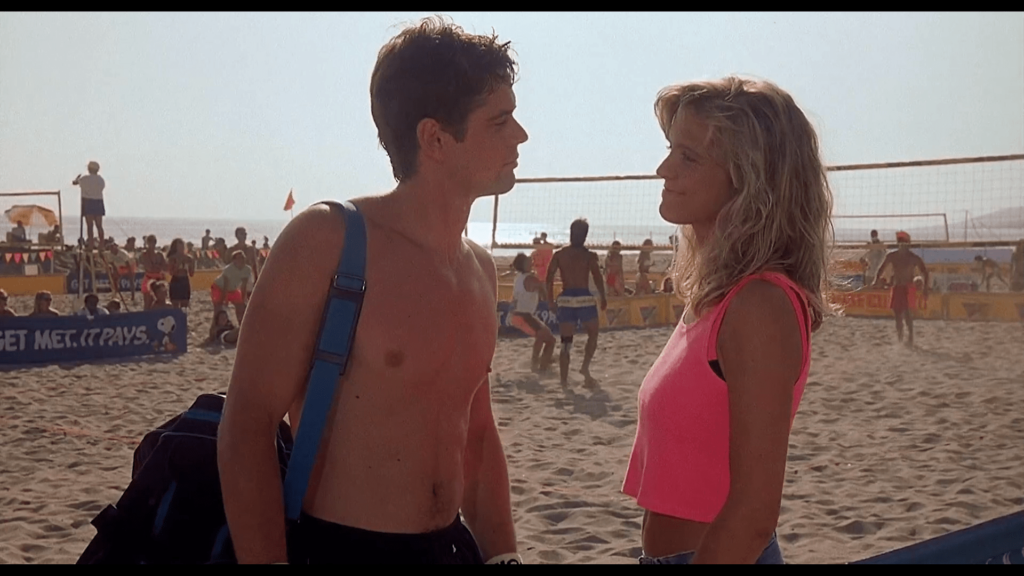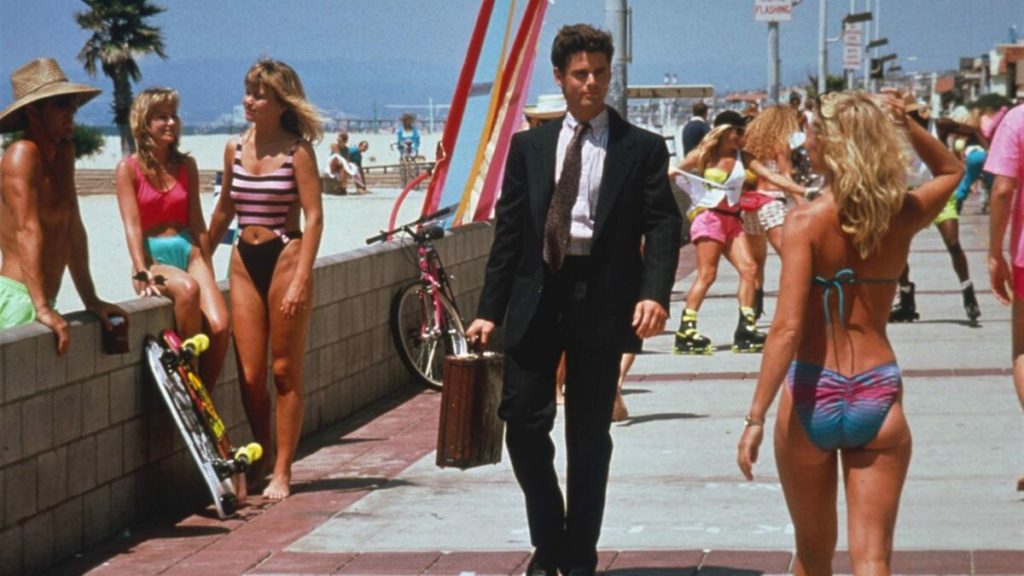C. Thomas Howell Makes a Play for Courtney Thorne-Smith on the Non-pro Beach Volleyball Circuit
DIRECTED BY PETER ISRAELSON/1990
BLU-RAY STREET DATE: FEBRUARY 22, 2022/MILL CREEK ENTERTAINMENT

1990’s Side Out is one of those movies that probably weilds more appeal now than when it first came out. At the time, it must’ve come and gone awfully quickly, blending into the glut of samey-same multiplex dreck. (I was paying pretty close attention to the film scene back then and have no recollection of this movie whatsoever). Today, Side Out plays most effectively as dorky nostalgia: guys in neon pink shorts and gals in crop tops; fun but half-forgotten needle-drops on the soundtrack; the “Mossimo” logo on every other person’s clothes. Even the film’s title is a reference to a now-defunct volleyball scoring system.
Back then, Side Out had the misfortune of being the final feature of upstart Aurora Pictures, which began with 1982’s The Secret of Nimh and went on to produce both Eddie and the Cruisers movies. No one saw Side Out then, and its financial non-performance sealed its studio’s fate, ka-thud! Today, the movie still isn’t very good. The sole feature directing credit for music video maker Peter Israelson, Side Out is a sunny beach volleyball movie in which all roads lead to The Big Match. This Big Match is particularly the kind of Big Match one would expect a movie like this (a couple of earnest white dude underdogs looking to be the best!) to culminate with: tense moments of sports attended by an unrealistic number of fans who are way too enthusiastic about such a distinctly amateur showdown. (These same fans might be fresh off the bus from rooting their hearts out for the competitive arm-wrestling finale of Over the Top).

For something so high stakes, it sure is instantly forgettable. C. Thomas Howell plays an aspiring legal eagle new to the coast from Milwaukee. His rich unscrupulous uncle gives him a luxurious place to live and a shot at the big-time serving pay-or-get-out notices to home occupants who are behind on payments. He loses all of that when he discovers both his conscious and beach volleyball, earning him a solid shot with a smart, cute bar waitress played by Courtney Thorne-Smith. So, he’s got that going for him. That’s his arc, and it’s wrapped up by the end of the first half of the movie.
That leaves the second half, which shifts its focus to the plight of a washed-up sand volleyball star with a gambling debt played by a Swayze-coifed Peter Horton. Horton’s character is an unreliable lady’s man who nevertheless decides to train C. Thomas Howell. Circumstances lead them to playing together on the local beach volleyball circuit, eventually landing them in that Big Match. But will Horton throw the game as he’s been instructed to, or will he persevere to be his best self in the face of uncertain victory?
Both Howell and Horton give their all to this stale premise, holding their own alongside a slew of actual pro beach volleyballers of the moment. Mostly though, Side Out is all about bronzed bods in fully extended jumps in front of a volleyball net, mostly in slow motion. Israelson serves up endless montages of bumps, sets, and spikes punctuated with a lot of high-fiving and back slapping, all set to pop music. Music rights being what they are these days, some of the tunes are impressive for their inclusion. Paula Abdul’s megahit “Straight Up” plays over the film’s very first sand volleyball game montage. “Roam” by the B-52s plays over a barroom tussle. There are plenty of other songs that are vaguely recognizable or not recognizable.

Mill Creek Entertainment has spiked Side Out into the still-competitive Blu-ray field as part of its “Retro VHS” line. That’s their ongoing collection of fondly forgotten titles from the video store era adorned with fun VHS rental-style slipcovers. It’s a fun conceit, giving a certain appeal to an array of movies that might otherwise be overlooked. Side Out’s slipcover proves far more suggestive than anything in the PG-13 movie itself. Its high-definition transfer is nice, except for one reoccurring shot in one scene that has a vertical green line going through the frame. It’s got a satisfying sound mix and no bonus features whatsoever. That’s what we’re served.


